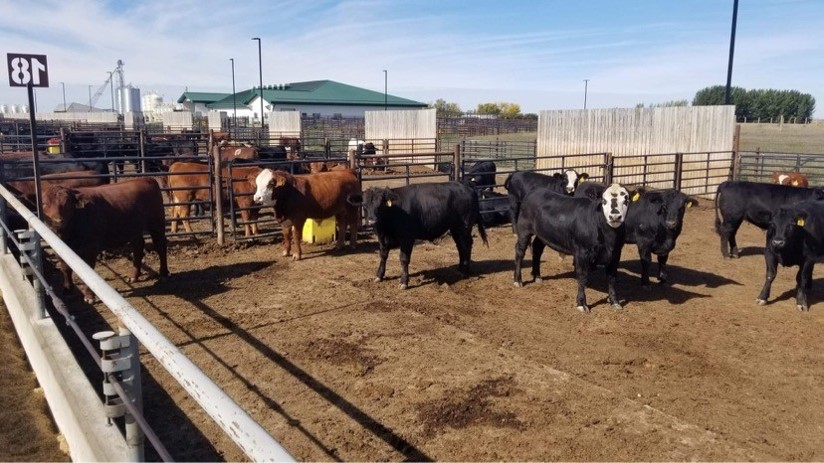AB Direct - Steers
Rail: ---
AB Direct - Heifers
Rail: ---
US Trade- Steers
Rail: ---
US Trade - Heifers
Rail: ---
Canadian Dollar
0.00

ABP Research Showcase Highlights | Reducing liver abscesses with forage
This is the fourth in a series of articles highlighting a selection of ABP-supported research projects that were featured at our Research Showcase in February 2023. Find the previous articles here.
Liver abscesses in finished cattle are on the rise, coming at a great cost to the Canadian beef industry.
Liver discounts due to abscesses led to an estimated loss of $61.2 million in 2016, up from $8.8 million in 1999, according to the 2017/2018 Canada Beef Quality Audit.
The antimicrobial tylosin is commonly used in high-grain finishing rations to reduce the incidence of rumen acidosis while maintaining the desired feed efficiency. However, concerns about increased antimicrobial resistance have prompted researchers to explore other methods for controlling liver abscesses.

Past research has shown that increasing the amount of forage in feeder cattle diets can reduce liver abscesses, said Gabriel Ribeiro, Saskatchewan Beef Industry Chair and assistant professor at the University of Saskatchewan (U of S). But this option isn’t always feasible, given the cost of forage and reduced feedlot performance.
This inspired U of S graduate student Tyen Paterson, who works with Ribeiro, to conduct a study on including forage in finishing diets as a method of liver abscess control. The study evaluated how different forage inclusion strategies impact liver abscess incidence and performance.
The findings of two related studies influenced the design of this project. The first study referenced found that feeding tylosin only at the start of the finishing process controlled liver abscesses to the same extent as when it was fed during the entire process.

“This suggested that we didn’t need to feed tylosin throughout the whole finishing phase,” said Ribeiro. “In this way, we could cut down the use of tylosin for 60 per cent or 70 per cent of the feeding period.”
The second study showed that when tylosin was fed only in the last month on feed, it offered no control of liver abscesses. This, Ribeiro explained, suggests that cattle may be “more at risk of developing liver abscess is in the beginning of the finishing phase,” before the animals are better adapted to a high-grain diet.
With this in mind, Paterson and Ribeiro hypothesized that feeding more forage at the start of the finishing period and then decreasing that amount through the process would help prevent liver abscesses while maintaining industry standard performance.
Study finds decreasing forage inclusion as effective as tylosin
After a 42-day adaptation period, 360 steers were finished at the U of S’s Livestock and Forage Centre of Excellence on one of four treatments. Each group was fed a concentrated ration of equal parts dry rolled wheat and barley, plus monensin throughout the trial and ractopamine during the final 42 days on feed.
There were two control treatments, both of which had a forage inclusion rate of 7.5 per cent on a dry matter basis for all four stages of the feeding process. The positive control treatment had tylosin added to the ration, making this treatment the closest to the industry standard, while the negative control treatment had no tylosin.
The third treatment began with a 15 per cent forage inclusion rate, then decreased to 9 per cent in the second stage and 3 per cent in the third and fourth stages. The fourth treatment started with a 3 per cent forage inclusion rate in the first two stages and increased to 9 per cent in the third stage and 15 per cent in the fourth stage.

While there wasn’t much difference in dry matter intake or feed efficiency between the four treatments, the increasing forage treatment resulted in greater differences in performance and carcass traits. The animals fed this ration had a lower average daily gain and finished at a lower weight than those fed the other three treatments. Accordingly, this led to lower carcass weights, lower yield scores, and less backfat thickness. The other three treatments had similar average daily gains, finished weights, carcass weights, and yield scores.
In terms of liver abscesses, the researchers found that on average, the decreasing forage treatment had the same level of liver abscess reduction as the positive control treatment with tylosin. On the flip side, the negative control and increasing forage treatments led to more liver abscesses.
When examining the severity of the abscesses present, there were fewer minor abscesses in the animals fed the positive control and decreasing forage treatments than those fed the negative control and increasing forage treatments. There was no difference across the treatments in the number of severe abscesses.
Ribeiro acknowledged that this research project was much smaller than past studies on liver abscesses, but the team was encouraged by the results regardless.
“Feeding that decreasing diet…had a similar effect in performance and liver abscesses as feeding the positive control by standard industry with tylosin added,” he summarized. “Feeding more forage at the end of your finishing period is not something you want to do or should be doing.”
This study was partially funded by Alberta Beef Producers. To learn about more ABP-supported studies and find fact sheets for completed and in-progress projects, visit our Research and Development webpage.


